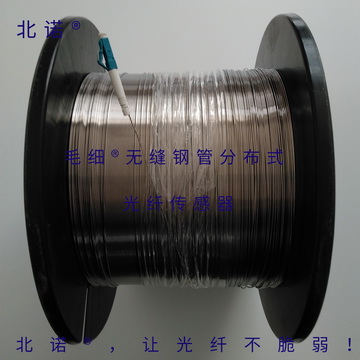Distributed Fiber Bragg Grating - Distributed FBG Sensor - String Multipoint Temperature/Strain Sensor - Concept Classification Advantage Video Difference
Table of Contents:
Ⅰ. What is Distributed Fiber Bragg Grating and FBG Fiber Bragg Grating String/Array
DCYS fabricates multiple Fiber Bragg Gratings with different wavelengths on a single fiber, forming a FBG string/array. After encapsulation by DCYS, the FBG Array can achieve multi-physical parameter and multi-point measurements. This kind of FBG Array is sometimes referred to as Distributed Fiber Bragg Grating.
Ⅱ. Classification of Distributed Fiber Bragg Grating Sensors
DCYS's commonly seen quasi-distributed fiber Bragg grating can be divided into conventional multi-point fiber Bragg grating array and weak reflectivity fiber Bragg grating array.
The conventional multi-point fiber Bragg grating array is demodulated using a regular fiber Bragg grating demodulator. Therefore, the number of fiber Bragg gratings that can be used is still limited by the wavelength frequency resources of the fiber Bragg grating demodulator, such as the commonly seen C-band or C+L-band. Due to wavelength spacing limitations, this type of distributed fiber Bragg grating can only achieve measurements of physical quantities with a limited number of measurement points.
The weak reflectivity fiber Bragg grating array is demodulated using a special fiber Bragg grating demodulator, which incorporates both frequency-division multiplexing and time-division multiplexing techniques outside of the frequency and wavelength spacing. Therefore, this kind of distributed fiber Bragg grating can basically achieve measurements with an infinite number of measurement points and is a true distributed fiber Bragg grating technology.
Ⅲ. Understanding Distributed Fiber Bragg Grating Sensors
A sensor encapsulated a distributed FBG Array is referred to as a serial fiber Bragg grating sensor, quasi-distributed fiber Bragg grating sensor, or array-type fiber Bragg grating sensor. DCYS's distributed fiber Bragg grating sensor can achieve multi-physical parameter and multi-point measurements, such as distributed temperature measurement and distributed strain measurement.
Ⅳ. Advantages of Distributed Fiber Bragg Grating Sensors
Quasi-distributed fiber Bragg grating sensors can achieve multi-point mixed measurements of multiple physical parameters with one sensor, including temperature, stress, strain, vibration, deformation, angle, etc., and can be easily used for networking.
Ⅴ. Principle Differences Between Distributed FBG Sensing Technology and Distributed Optical Fiber Sensing Technology
There are fundamental differences in principles between quasi-distributed FBG sensors and distributed optical fiber sensors which are based on Raman scattering, Rayleigh scattering, and Brillouin scattering technologies. The differences are as follows:

This article introduces the principles of distributed optical fiber sensing technology, as well as the concepts of Raman scattering, Rayleigh scattering, and Brillouin scattering. The principles of fiber optic grating sensing technology are also described, and the differences between these two technologies are compared. This lays the foundation for understanding the usage environments and how to choose between distributed optical fiber sensors and fiber optic grating sensors.
Video is below:
Ⅵ. Application Differences Between Distributed FBG Sensing Technology and Distributed Optical Fiber Sensing Technology
There are also fundamental differences in applications and scope of application between quasi-distributed FBG sensors and distributed optical fiber sensors which are based on Raman scattering, Rayleigh scattering, and Brillouin scattering technologies. The differences are as follows:

This article introduces the different environments of distributed optical fiber sensors and fiber Bragg grating sensors from multiple perspectives, and briefly compares the advantages and disadvantages of fiber Bragg grating sensing technology and distributed optical fiber sensing technology based on Raman scattering, Rayleigh scattering, and Brillouin scattering. Understanding these differences is important to choose the appropriate fiber sensing technology, and select OFSCN's corresponding series of fiber Bragg grating sensors or distributed optical fiber sensors.
